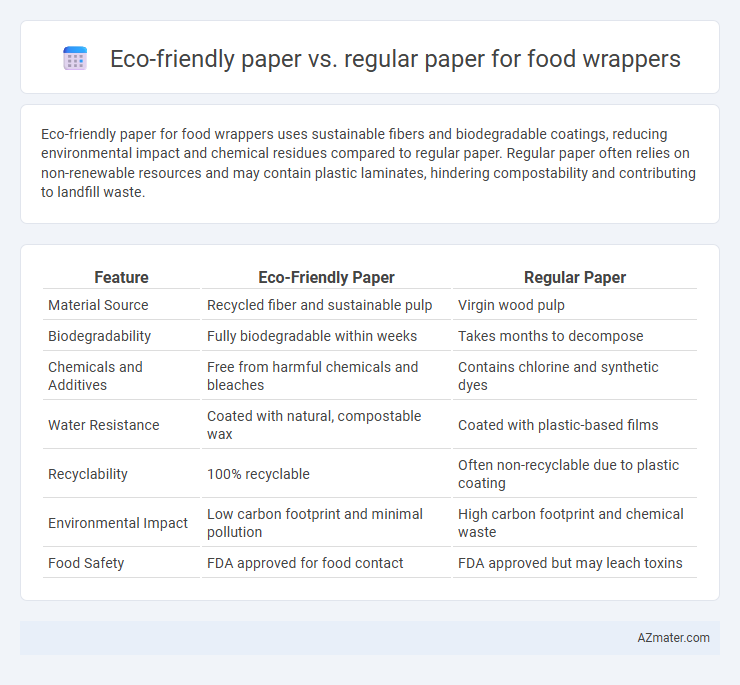Eco-friendly paper for food wrappers uses sustainable fibers and biodegradable coatings, reducing environmental impact and chemical residues compared to regular paper. Regular paper often relies on non-renewable resources and may contain plastic laminates, hindering compostability and contributing to landfill waste.
Table of Comparison
| Feature | Eco-Friendly Paper | Regular Paper |
|---|---|---|
| Material Source | Recycled fiber and sustainable pulp | Virgin wood pulp |
| Biodegradability | Fully biodegradable within weeks | Takes months to decompose |
| Chemicals and Additives | Free from harmful chemicals and bleaches | Contains chlorine and synthetic dyes |
| Water Resistance | Coated with natural, compostable wax | Coated with plastic-based films |
| Recyclability | 100% recyclable | Often non-recyclable due to plastic coating |
| Environmental Impact | Low carbon footprint and minimal pollution | High carbon footprint and chemical waste |
| Food Safety | FDA approved for food contact | FDA approved but may leach toxins |
Introduction to Food Wrappers: Eco-Friendly vs Regular Paper
Eco-friendly paper food wrappers are made from sustainable materials like recycled fibers or biodegradable components, reducing environmental impact and supporting zero-waste goals. Regular paper wrappers often use non-recycled fibers and chemical coatings, which hinder biodegradability and contribute to landfill waste. Choosing eco-friendly paper enhances food safety through natural materials while promoting environmental sustainability in packaging practices.
Environmental Impact of Paper Production
Eco-friendly paper for food wrappers significantly reduces environmental impact by utilizing recycled fibers and sustainable sources, lowering deforestation rates compared to regular paper. The production of eco-friendly paper consumes less water and energy, and releases fewer greenhouse gases and pollutants during manufacturing. Regular paper production typically involves intensive chemical processing and higher carbon emissions, contributing to habitat destruction and increased landfill waste.
Material Composition: What Sets Eco-Friendly Paper Apart?
Eco-friendly paper for food wrappers is primarily made from renewable resources such as recycled fibers, agricultural residues, or sustainably harvested wood pulp, significantly reducing environmental impact compared to regular paper derived from virgin wood pulp. It often incorporates biodegradable or compostable coatings made from plant-based materials like cornstarch or PLA, unlike conventional plastic or chemical coatings found in regular paper that hinder recyclability. The use of non-toxic inks and adhesives further distinguishes eco-friendly paper, ensuring safer disposal and minimal contamination during recycling processes.
Biodegradability and Compostability: A Key Difference
Eco-friendly paper for food wrappers is primarily designed to be biodegradable and compostable, breaking down naturally without harming the environment. Regular paper often contains chemical coatings or additives that hinder decomposition and contribute to landfill waste. Choosing biodegradable, compostable wrappers significantly reduces ecological impact by promoting sustainable disposal methods.
Food Safety and Hygiene Considerations
Eco-friendly paper food wrappers often use natural, non-toxic materials and biodegradable coatings that reduce the risk of chemical contamination, enhancing food safety and hygiene. Regular paper wrappers may contain synthetic additives or chlorine-based bleaches, which can leach harmful substances onto food, posing potential health risks. Choosing eco-friendly paper ensures compliance with stringent food safety standards while minimizing environmental impact.
Cost Comparison: Upfront and Long-Term Expenses
Eco-friendly paper food wrappers typically have higher upfront costs due to sustainable sourcing and biodegradable materials, but their long-term expenses decrease because they reduce waste disposal fees and compliance costs with environmental regulations. Regular paper food wrappers tend to be cheaper initially but may incur higher long-term costs linked to landfill fees and potential environmental fines. Businesses prioritizing sustainability often find that investing in eco-friendly paper leads to overall cost savings and enhanced brand value over time.
Performance and Durability in Food Wrapping
Eco-friendly paper for food wrapping offers comparable grease resistance and moisture barrier properties to regular paper, enhancing food safety and freshness. Biodegradable coatings in eco-friendly paper improve durability without compromising compostability, making it suitable for various food types. Regular paper often relies on synthetic additives for performance, which may hinder recyclability and environmental sustainability.
Consumer Perception and Eco-Conscious Branding
Eco-friendly paper for food wrappers is perceived by consumers as a sustainable choice that aligns with growing environmental concerns, enhancing brand loyalty and trust. Its biodegradable and recyclable qualities contribute to positive eco-conscious branding, differentiating products in competitive markets. Brands leveraging eco-friendly packaging often experience increased consumer engagement and preference over traditional regular paper alternatives.
Regulatory Standards for Food Contact Papers
Eco-friendly paper used for food wrappers must comply with stringent regulatory standards such as the U.S. FDA's 21 CFR Part 176, which governs paper and paperboard materials intended for food contact, ensuring no harmful substances migrate into food. Regular paper often fails to meet these rigorous criteria due to the presence of non-food-grade inks, coatings, or chemical additives that can pose health risks. Compliance with international standards like EU Regulation No 10/2011 also mandates testing for heavy metals and overall migration limits, making eco-friendly paper a safer, certified option for food contact applications.
Future Trends in Sustainable Food Packaging
Eco-friendly paper for food wrappers incorporates recycled fibers and biodegradable coatings, reducing environmental impact compared to regular paper, which often relies on virgin pulp and non-renewable additives. Innovations in sustainable food packaging emphasize compostable materials and enhanced barrier properties to extend shelf life without harmful chemicals. Future trends focus on integrating nanotechnology and plant-based polymers to create fully recyclable, eco-conscious wrappers that meet increasing consumer demand for green solutions.

Infographic: Eco-friendly paper vs Regular paper for Food wrapper
 azmater.com
azmater.com